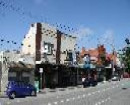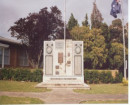FORMER CARLTON CRECHE
101-111 NEILL STREET CARLTON, MELBOURNE CITY
-
Add to tour
You must log in to do that.
-
Share
-
Shortlist place
You must log in to do that.
- Download report
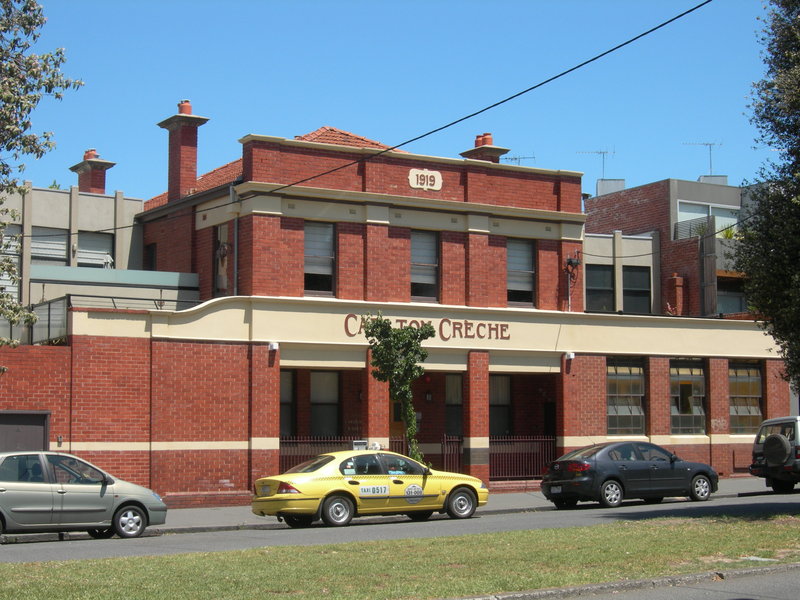

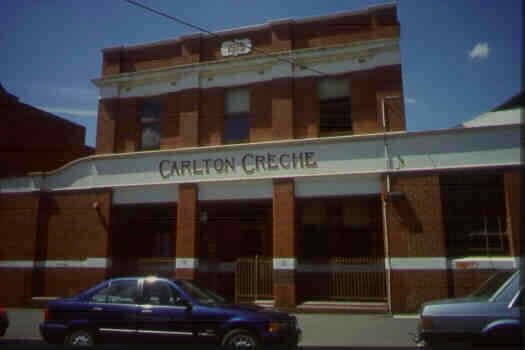
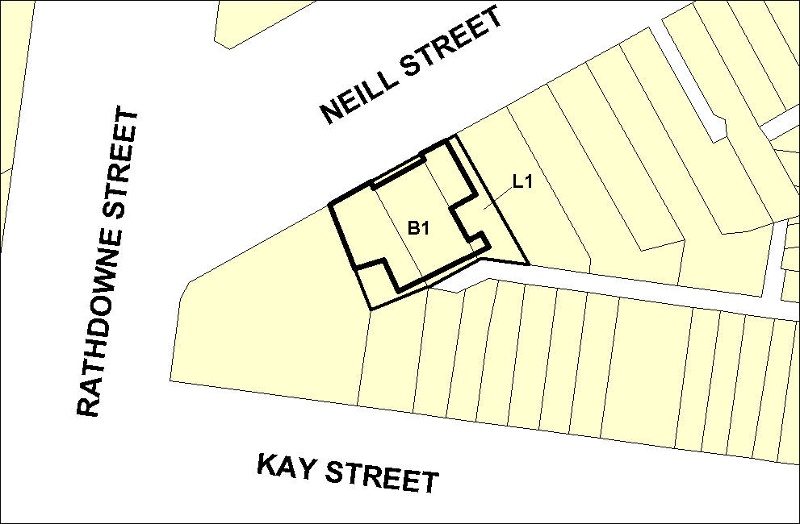
Statement of Significance
The Former Carlton Creche is a two storey building constructed in 1919 to cater for the children of working mothers in the Carlton area.
How is it significant?
The Former Carlton Creche is architecturally and historically significant to the State of Victoria.
Why is it significant?
The Former Carlton Creche is architecturally significant as the first purpose-built creche or day nursery constructed in Melbourne. The Carlton Creche is representative of an early twentieth century welfare institution. Its architectural form, with simple lines and lack of decoration, reflects the charitable purpose of the institution which allowed for no extravagance.
The Former Carlton Creche is historically significant as the first purpose-built creche or day nursery constructed in Melbourne. It catered for the children of working class parents in the Carlton area. At first these were the children of widows, deserted wives and wives with 'useless husbands', who were encouraged to work in domestic service. The use of the Creche reflected social change within Victoria, and particularly social attitudes to working women and their children, for a period of eighty years.
The Former Carlton Creche is historically significant as a welfare institution which catered to the needs of migrant families during the years after World War II.
The Former Carlton Creche is historically significant as an unusual response to the needs of children and working women in the early twentieth century, since women were generally expected to care for their own children at home. It was, in part, an attempt to impose middle class values on working class children in order to promote the health of future citizens and to militate against the effects of a slum environment which was considered injurious to health and morality.
-
-
FORMER CARLTON CRECHE - History
Contextual History:
Child Welfare
The inner suburban creches founded at the turn of the century were important in the history of social welfare in the State in providing a high standard of care under the supervision of a trained nurse for children whose mothers were obliged to work through financial necessity.
Scandals associated with baby farming were still occurring in the 1890s. The case of Rita Knorr who took in infants to care for in her Brunswick home received much publicity in 1893 when the bodies of three infants were found buried in her garden. Knorr was found guilty of murder and hanged. (Jaggs, Donella. Neglected and Criminal: Foundations of Child Welfare Legislation in Victoria, .p.84)
In the late nineteenth century and the early years of the twentieth century, a greater emphasis on hygiene and nutrition in child rearing emerged. Attitudes to poverty changed in the 1890s. Where poverty had often been seen earlier in the century as the result of alcohol, laziness and lack of thrift, the economic depression of the early 1890s caused difficulties to many hardworking and respectable workers. The suffering of the poor was brought to the attention of the community and it became clear that many of the poor were in need through no fault of their own. They had lost their homes and savings through the failure of the banks and the loss of employment. This recognition changed the climate of opinion in Australia so that it was possible for the poor to be seen as deserving help.
Attitudes to children had also changed. The provision of free secular and compulsory education in Victoria from 1872 was seen not only as a means of educating future citizens but also preventing crime by keeping children occupied and supervised. The kindergarten movement drew attention to the needs of preschool children .
The Carlton Creche demonstrates the importance society placed on respectability for the working class women in the early twentieth century. Hard work and independence were values encouraged by the middle class women who founded this institution. The provision of child care enabled working women to keep their children at home rather than seek a place in an orphanage for them. Places for their children at the creche enabled women to work in domestic service or, later, in local factories.
The first creche in Melbourne opened at Collingwood in 1886, followed by Prahran in 1890, Richmond in 1891, Brunswick in 1895, Fitzroy in 1899, Carlton in 1900, North Melbourne in 1903, South Melbourne in 1910 and the City (Ethel Nilsson) in 1916. The Salvation Army started the Children's Creche, a residential nursery for preschool children in 1915, in a two-storey building in Canning Street, North Carlton opened in August 1916. The building has since been demolished although the facade remains. (Among the Terraces: Family Support in Carlton. North Carlton, Carlton Forest Project, 1991. P. 15)
During World War I, a creche was opened at Ballarat. By the late 1920s, creches were also operating at Footscray and Northcote. A creche at Geelong was opened in 1967 and one at Broadmeadows in 1971.
After World War II, the Victorian Association of Day Nurseries became the body coordinating the eleven creches operating in the State. The association lobbied for a trained kindergarten teacher in every creche, a social worker and a supervisor to advise and assist children, parents, staff and committees. The first social worker was employed in 1946. A number of creches, such as Prahran in 1948, handed over responsibility for management to their local councils, but Carlton remained under its own committee of management.
History of Place:
The Carlton Creche, built in 1919, is believed to be the first purpose-built creche or day nursery constructed in Victoria. Opened in 1900, after the economic depression of the 1890s, the Carlton Creche catered for the children of working class parents in the Carlton area. At first these were the children of widows, deserted wives and wives with ?useless husbands?, who were encouraged to work in domestic service in the middle class houses of Carlton. The Carlton Creche was non-denominational and was organised by a voluntary committee of women known as the Carlton Creche Society. The honorary solicitor and honorary physician were the husbands of women on the committee.
The Carlton Creche demonstrates an unusual response to the needs of children and working women in the early twentieth century, since women were generally expected to care for their own children at home. It was, in part, an attempt to impose middle class values on working class children in order to promote the health of future citizens. The slums of Carlton and other inner industrial suburbs were poor environments for young children. Children from slum areas who came to the attention of health authorities were found to be inadequately fed and housed and had many health problems.
Women whose husbands were ill or unemployed, had died or were in gaol were helped by the Creche. There was no welfare provision for those women whose husbands died until the middle of the twentieth century. A widow?s pension was introduced by the Commonwealth Government in 1942.Child endowment was introduced by the Menzies Government in 1940. Initially it was five shillings a week for the second and subsequent children under 16 years of age. The scheme was extended to first and only children in 1950. (Among the Terraces: Family Support in Carlton. North Carlton, Carlton Forest Project, 1991. P. 18) Historian Shurlee Swain (personal communication, November 1999) believes that single mothers frequently represented themselves as deserted or widowed to such charities as the Carlton Creche, because charities which publicly helped single mothers would be labelled as encouraging immorality and community support withdrawn. During the 1930s depression, women whose families had no other income sought positions as domestic servants and needed child care for their preschool children. During World War II, women with children were encouraged to work to help the war effort, particularly in the munitions industry. At times, some creches in Melbourne operated 24 hours a day to cater for women working shift work in essential wartime work.
The provision of places to children of single mothers was not publicised, though welfare historian Shurlee Swain believes that this support was given over the whole period of the creche?s existence. The women on philanthropic committees had a philosophic stance which was in opposition to single motherhood, but they were pragmatic about supporting mothers and children in difficulties. They had to appeal for money for needy women and children without being seen to encourage sin. Open support for single mothers was not possible until the 1970s.
After the war, the heavy concentration of Jewish, Italian and other migrants in Carlton and Fitzroy where cheap housing was available changed the population in the creche. A large percentage of the children were migrants, and the provision of child care enabled women to work in local factories to establish themselves in Australia. Traditional child minding arrangements by grandmothers or other members of an extended family were preferred but frequently were not available to migrant families. At a time when Australian women were encouraged by societal values to stay home to rear families, migrant women were the major clients of child care services.
The Carlton Creche was administered by the Carlton Creche Society, a group of middle class women, mostly wives of Melbourne City Councillors, local businessmen and merchants, doctors and other professionals. The voluntary committee was formed in 1900 in Carlton and a creche began operating in the front room of a house in Lygon Street. The creche moved to other premises at 558 Lygon Street around 1913. The wife of the Lord Mayor in the 1920s, Lady Brunton, Jessie Webb and other influential women were on the committee.
The institution started out as a local establishment, but in time its aims became more general.
In 1935 the Society acquired two neighbouring cottages in Neill Street, which were demolished and the wrecker was paid £86.2.0 to take them away. The new extension was completed in February 1936 and the Lady Mayoress opened the building on 25 March 1936.
By 1947-48, the committee was no longer dominated by local residents. The office-bearers came from addresses in Carlton, North Carlton and North Fitzroy, but also from Malvern, Kew, South Yarra, Toorak and Canterbury. The President, Mrs S. Cook, lived in Malvern. Women occupied positions of Hon. Treasurer, Hon. Secretary and Hon . Auditor: the Hon. Solicitor, Mr W. Townsend, and the Hon. Physician, Dr A. McCutcheon, were the only two males involved, apart from the trustees who were the husbands of two of the committee.
The impetus to found such a centre came partly from a belief that children could be rescued from undesirable home environments by the philanthropic work of middle and upper class women. The educational benefits of the creche could militate, it was believed, against the detrimental effects of the slum backgrounds of the children.
The committee assisted the mothers by finding them suitable employment, usually as domestic servants, cleaning, ironing or laundering. Monthly meetings for the mothers were held at the Creche as a means of educating them on child care and for social contact with other mothers. The children were given free medical treatment and dental care and, in the later years, immunisation was carried out at the Lady Gowrie Child Care Centre (founded in 1939) in Canning Street.
During World War II, women with children were encouraged to work to help the war effort, particularly in the munitions industry, and creches received government subsidy for the first time. After the war, the heavy concentration of Jewish and Italian migrants in Carlton and Fitzroy where cheap housing was available, changed the population in the creche. A large percentage of the children were from migrant families, and the provision of child care at the Creche enabled women to work in local factories to establish themselves in Australia. Traditional child minding arrangements by grandmothers or other members of an extended family were frequently not available to migrant families. Subsequent waves of migration led to the Creche assisting migrant parents of many nationalities, as well as single mothers from the nearby Housing Commission flats.
By 1947-48, the committee claimed that the institution was ? a social necessity? and reiterated its policy that places be offered only to ?children of mothers forced by economic or domestic reasons to go out to work?. Their aim was to ?overcome the economic and social factors which otherwise might prejudice the whole life of the growing child?.
The first floor of the Carlton Creche building contained quarters for the Matron who lived on site until 1969. Sister Belinda Harry, matron from 1948 to1969, was the last Matron to occupy the upstairs quarters. Also on the first floor was the Committee Room.
In the 1970s, the clients of the creche were often single mothers who were encouraged by social workers to keep their babies. Some of these came from the nearby Housing Commission flats. Migrant women also from the Housing Commission flats brought their children to the creche. Each wave of migration brought an influx of children. Each national group stayed in the flats about three years before moving on and making way for the next. Most of these were factory workers. (Sister Joan Lenaghan, Matron, 1969-95, personal communication, November 1996).
More recently, the creche admitted children from families where both parents worked. The gentrification of the inner suburbs brought applications from middle class families who had moved into the neighbourhood. To avoid accusations of discrimination against the two-parent family, children of single mothers were no longer given preference. The better-off families were charged according to their means and this allowed the creche to admit others at very low fees. All paid some fee.
The Creche received support from the local community. At football matches at the Carlton Football Ground, a sheet was taken around the ground to collect donations for the Creche. Spectators would throw pennies or other coins into the sheet. The Creche was registered as a benevolent society under the Hospitals and Charities Act so that all donations were tax exempt. State Government funding was received for the first time in 1945, on a per capita basis.
The committee women were enthusiastic supporters of their charity. In some cases, the daughters of early committee members followed their mothers on to the committee. One President, Mrs Foletta, kept a collection tin on her hall table at home on which was written 'Something for the Carlton Creche': visitors were expected to donate a silver coin.
In 1988, the Carlton Creche was amalgamated with the Queen Elizabeth Centre. In April 1998, government policy changes limited childcare assistance per child per week to twenty hours. As a result in December 1998, the creche was closed. (Cheryl Crockett. For The Babies' Sake: The History of the Queen Elizabeth Centre. (in press, 1999)FORMER CARLTON CRECHE - Assessment Against Criteria
a. The historical importance, association with or relationship to Victoria's history of the place or object
The Carlton Creche, constructed in 1919, is important as the first purpose built creche or day nursery constructed in Victoria. The inner suburban creches founded at the turn of the century were important in the history of social welfare in the State. They provided a high standard of care under the supervision of a trained nurse for children whose mothers were obliged to work through financial necessity.b. The importance of a place or object in demonstrating rarity or uniqueness
The Carlton Creche is a rare example of a purpose built facility constructed in the early twentieth century for the day care of working class children.c.The place or object's potential to educate, illustrate or provide further scientific investigation in relation to Victoria's cultural heritage
d.The importance of a place or object in exhibiting the principal characteristics or the representative nature of a place or object as part of a class or type of places or objects
The Carlton Creche is representative of an early twentieth century welfare institution. Its architectural form, with simple lines and lack of decoration, reflects the charitable purpose of the institution which allowed for no extravagance.
g. The importance of the place or object in exhibiting good design or aesthetic characteristics and/or in exhibiting a richness, diversity or unusual integration of features
N/A
g. The importance of the place or object in demonstrating or being associated with scientific or technical innovations or achievements
N/A
g. The importance of the place or object in demonstrating social or cultural associations
The Carlton Creche demonstrates an unusual response to the needs of children and working women in the early twentieth century, since women were generally expected to care for their own children at home. It was, in part, an attempt to impose middle class values on working class children in order to promote the health of future citizens and to militate against the effects of a slum environment which was considered injurious to health and morality.
h.Any other matter which the Council deems relevant to the determination of cultural heritage significanceFORMER CARLTON CRECHE - Permit Exemptions
General Exemptions:General exemptions apply to all places and objects included in the Victorian Heritage Register (VHR). General exemptions have been designed to allow everyday activities, maintenance and changes to your property, which don’t harm its cultural heritage significance, to proceed without the need to obtain approvals under the Heritage Act 2017.Places of worship: In some circumstances, you can alter a place of worship to accommodate religious practices without a permit, but you must notify the Executive Director of Heritage Victoria before you start the works or activities at least 20 business days before the works or activities are to commence.Subdivision/consolidation: Permit exemptions exist for some subdivisions and consolidations. If the subdivision or consolidation is in accordance with a planning permit granted under Part 4 of the Planning and Environment Act 1987 and the application for the planning permit was referred to the Executive Director of Heritage Victoria as a determining referral authority, a permit is not required.Specific exemptions may also apply to your registered place or object. If applicable, these are listed below. Specific exemptions are tailored to the conservation and management needs of an individual registered place or object and set out works and activities that are exempt from the requirements of a permit. Specific exemptions prevail if they conflict with general exemptions. Find out more about heritage permit exemptions here.Specific Exemptions:General Conditions:
1. All exempted alterations are to be planned and carried out in a manner which prevents damage to the fabric of the registered place or object.
2. Should it become apparent during further inspection or the carrying out of alterations that original or previously hidden or inaccessible details of the place or object are revealed which relate to the significance of the place or object, then the exemption covering such alteration shall cease and the Executive Director shall be notified as soon as possible.
3. If there is a conservation policy and plan approved by the Executive Director, all works shall be in accordance with it.
4. Nothing in this declaration prevents the Executive Director from amending or rescinding all or any of the permit exemptions.
5. Nothing in this declaration exempts owners or their agents from the responsibility to seek relevant planning or building permits from the responsible authority where applicable.
Exterior
1.Minor repairs and maintenance which replace like with like.
2. Removal of extraneous items such as air conditioners, pipe work, ducting, wiring, antennae, aerials etc, and making good.
3.I nstallation or repair of damp-proofing by either injection method or grouted pocket method.
4. Regular garden/yard maintenance.
5. Installation, removal or replacement of garden watering systems, provided the installation of the watering systems do not cause short or long term moisture problems to the building.
5. Laying, removal or replacement of paving in the gardens and the courtyards.
6. Repair, removal or replacement of existing garden/yard structures.
Interior
1.Minor repairs and maintenance which replace like with like.
2. Painting of previously painted walls and ceilings provided that preparation or painting does not remove evidence of the original paint or other decorative scheme.
3.Removal of false ceiling in kitchen to reveal original timber lined ceiling.
4. Removal of paint from originally unpainted or oiled joinery, doors, architraves and skirtings
5. Repair of plasterwork provided that all new work matches good adjacent work in style, detail and finish.
6. Installation, removal or replacement of carpets and/or flexible floor coverings, eg vinyl.
7. Installation, removal or replacement of curtain track, rods, blinds and other window dressings.
8. Installation, removal or replacement of hooks, nails and other devices for the hanging of mirrors, paintings and other wall mounted artworks.
9. Refurbishment of bathrooms and toilets including removal, installation or replacement of sanitary fixtures and associated piping, mirrors, wall and floor coverings.
10. Installation, removal or replacement of kitchen benches and fixtures including sinks, stoves, ovens, refrigerators, dishwashers etc and associated plumbing and wiring.
11. Installation, removal or replacement of ducted, hydronic or concealed radiant type heating provided that the installation does not damage existing skirtings and architraves and provided that the location of the heating unit is concealed from view.
12. Installation, removal or replacement of electrical wiring provided that all new wiring is fully concealed and any original light switches, pull cords, push buttons or power outlets are retained in-situ. Note: if wiring original to the place was carried in timber conduits then the conduits should remain in-situ.
13. Installation, removal or replacement of bulk insulation in the roof space.
14. Installation, removal or replacement of smoke detectors.FORMER CARLTON CRECHE - Permit Exemption Policy
Policy
It is the purpose of the permit exemptions to allow works that do not impact on the significance of the place to occur without the need for a permit.
-
-
-
-
-
LOTHIAN BUILDINGS
 Victorian Heritage Register H0372
Victorian Heritage Register H0372 -
SHOPS AND RESIDENCES
 Victorian Heritage Register H0043
Victorian Heritage Register H0043 -
POLICE STATION
 Victorian Heritage Register H1543
Victorian Heritage Register H1543
-
1 Brockenshire Street
 Yarra City
Yarra City -
1 Bundara Street
 Yarra City
Yarra City -
1 Forster Street
 Hobsons Bay City
Hobsons Bay City
-
-






